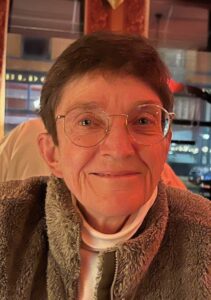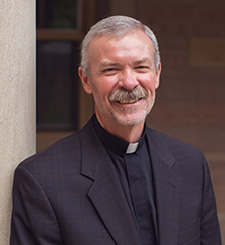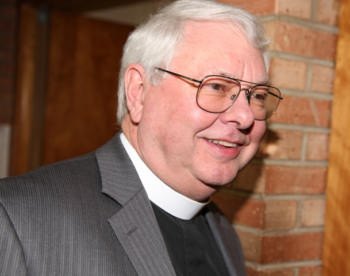
The Seminex logo was designed by Professor Bob Werberig.
On February 19, 1974, following the suspension of Concordia Seminary President Rev. John Tietjen by the Lutheran Church-Missouri SYnod President Jacob Preus, most of the seminary faculty and student body lead a walk out from the campus. The controversy swirling around the suspension and the walk out led to defining events in the Lutheran church in the United States. A reconfiguring within the Lutheran community occurred, and the ramifications can still be felt today. But, for many persons, it was personal. For many individuals, this event was definitional and was one of their most challenging and exciting experiences, framing their ministries. On the one hand, lives were disrupted and friendships sometimes ended, even within family groups. On the other hand, people who chose to leave or were forced to leave were living out a vision of what the gospel life required. They were doing more than simply coasting through their spiritual life.
Below you will find three reflections written by ELCA church leaders who have deep historical connection to the walk out at Concordia Seminary, St. Louis, and to the development of the “Seminary in Exile” — Seminex. It is an important part of the history of the ELCA, and one that had profound impact on those leaders who lived through the experience.
A reflection by Pastor Jane Buckley-Farlee, a version of which first appeared in the Trinity Congregation newsletter: 
It’s odd when something that has had a big effect on your life isn’t even a real word. That word for me is Seminex. You may have heard me say “Seminex” now and then and you might have never even wondered what it was. February 19, 2024, is the 50th anniversary of Seminex, and the anniversary of the great walk-out from Concordia Seminary. Because this is an important anniversary, I’ll fill you on some of what this is all about.
Seminex is short for “Concordia Seminary in Exile.” (It later became Christ Seminary – Seminex.) Seminex existed from 1974-1987. From the 1950s through the 197’s Protestant churches in the U.S. were dividing over several issues. At the time there were on-going controversies over the Fundamentalist-Modernist issues. The disagreements were about the authority of Scripture and the role of Christianity. The understanding of these were very basic for many of the churches at the time, including the Lutheran Church-Missouri Synod (LCMS).
Concordia Seminary had been considered the flagship seminary of the two seminaries in LCMS. In the ‘50s professors at Concordia began teaching the historical-critical method for studying the Bible in place of the historical-grammatical method. This led to many clergy and members of the LCMS in the 1960s to worry about the direction the education at Concordia Seminary was taking. It was becoming too liberal.
The historical-grammatical method basically said that the scripture was the inerrant Word of God, handed down directly by God. This meant that there were no contradictions or mistakes anywhere in the Bible and all of it should be taken literally, word for word. The historical-critical method instead taught that there are contradictions (check out Genesis 1 and 2) and that to understand the Bible you have to look at it taking into consideration who wrote it, when, where, and what kind of literature it was.
THIS MIGHT NOT SOUND like a big deal, but it was. For example, take the two different methods with the two creation stories. With the historical-grammatical method you have to take the story literally: that creation happened in six twenty-four hour days. It didn’t matter what science had learned. It didn’t matter that the two creation stories are different — one says it took six days and the other says two, among other differences.
The historical-critical method said that, of course, God could have done that all in six days; God can do anything. But with scholarly investigation it became clear that several people had a part in writing Genesis and that it wasn’t meant to be about “how” the world was created. Instead, it was about “Who” created it, and that was God.
This is a simplified version of the arguments. But it reached a point where it became a measure of faith, of salvation. One had to believe in a seven-day creation to be right. One had to believe that Jonah literally spent three days in the stomach of a whale, that God literally flooded the entire planet and killed all life beyond what was on Noah’s ark, etc. If you couldn’t believe that, how were you to be certain about what it said about Jesus? It was decided that this was the only method that was to be taught at Concordia Seminary. If someone could not teach that method, their faith was in question, and their salvation could be also.
This might not sound like a big deal, either. But it is. To have to believe the Bible literally meant that salvation was no longer solely dependent on God’s grace, but rather on whether you believed correctly. If you didn’t, your salvation could be in question. This is not a Lutheran approach, or even a biblical approach, for that matter. But this was the only method that was deemed to be acceptable to be taught in the LCMS.
The president of Concordia Seminary, John Tietjen, agreed with and supported the faculty when it came to teaching using the historical-critical method. After several years of back and forth debate, including grueling faculty interviews with the Board of Control of the Seminary, pages and pages of documentation, and jockeying back and forth at Synod conventions on various issues, it was decided that John Tietjen was to be fired along with the vast majority of the faculty who stood with him. Forty faculty members out of forty-five walked off the Concordia Seminary campus on February 19, 1974. The same proportion of students walked off with them. As they walked off the campus they sang “The Church’s One Foundation.”
Those who walked off in many ways lost everything. The faculty and staff lost their jobs. Much of the faculty lived in campus housing. They had ten days to move. Students were left in limbo not knowing what the future would hold. Would there be any churches that would take the students of Seminex as interns (we called them vicars) or would there be any churches that would ever call them as pastors? Many families in the LCMS were split over this and remain split still.
But the new Seminex came into being. For me it was a place to begin to understand the unlimited, unbounded grace and love of God. It was a gift because those who taught that had given up so much for it. They would say it was for the sake of the gospel. And I think they were right. The gospel was in the bones of Seminex.
A reflection by Bishop Steve Delzer: 
The handwriting was on the wall already in my second year (1972-73) at Concordia Seminary, St. Louis. Off to Vicarage (Internship), I went to St. Paul’s Lutheran Church in Glen Burnie, Maryland, for the 1973-74 academic year, which meant that I was not on the Seminary campus for the walkout in February 1974. But I was certainly there “in spirit,” fully supportive of the exodus from Concordia and into the new reality known as Seminex (Concordia Seminary in Exile).
J.A.O. Preus was present at the 1974 Southeastern District Convention. Those of us on Vicarage in the District asked to meet with him to ask what we would be going back to, considering that the majority of faculty had left, if we returned to Concordia for our fourth year. His response was: “We have plenty of people with doctoral degrees who can teach at the Seminary.” That response convinced me that I would be returning to Seminex for my fourth year.
One of my first conversations upon returning to Seminex was with Doc Caemerer, my homiletics professor. He described for me what this whole experience had been like for him, and that this was really about the Gospel. That conversation convinced me that I had made the right decision. And I have always been so grateful to the staff, faculty, and students at St. Louis University, Eden Seminary, and Washington University who provided us with space and support.
I WILL ADMIT THAT it was a challenging year, but one bright spot was that whether students chose to return to Concordia or to Seminex, most of us remained friends. During the year, many of us at Seminex traveled to congregations around the country together with professors and other staff to tell the Seminex story. There was certainly some anxiety as graduation neared, knowing that we faced the reality that we would not be certified as pastors in the LCMS, and therefore not be placed in LCMS congregations. I was fortunate that my Vicarage congregation in Glen Burnie voted to call be back as the assistant pastor, and eventually I was certified and ordained.
I chose to remain in the LCMS for about 25 years, trying to work for change within the system. Eventually that became untenable and in 1999 I resigned from the roster of the LCMS and was received onto the roster of the ELCA where I served for over 20 years.
A reflection by Pastor Mark Wegener: 
After I graduated from Concordia Seminary in St. Louis in 1968, my first parish was about 50 miles east of there, a small-town rural congregation in southern Illinois. After a year or two, I started taking post-graduate courses back at the Sem, which was only about an hour’s drive away. This was at the time when anti-seminary rhetoric was beginning to ramp up. The issue was the introduction of “historical critical” methods of interpreting the Bible. Those of us who supported the professors who taught in this style were labeled as “Bible doubters” and even “Christ deniers.”
In 1974 when push came to shove, the minions of LCMS president Jacob Preus managed to get seminary president John Tietjen ousted from his position. And in response to that, the majority of the faculty and the student body walked out of the campus. I was not actually present that day, but because I was still taking courses I counted myself among them. Eventually the faculty regrouped as Concordia Seminary in Exile, or “Seminex” for short, and taught classes on the campus of the Jesuit-run St. Louis University.
Later that summer I accepted a call to a small congregation in North Chicago, Illinois, about halfway between Chicago and Milwaukee, next to the Great Lakes Naval Base. I continued taking courses, some by correspondence, some at neighboring seminaries, some during the summer session back in St. Louis. Two years later I graduated with a Masters of Sacred Theology when the third Seminex graduation ceremony was held at Washington University in St. Louis. Our degrees were authenticated by the Lutheran School of Theology at Chicago. At that time the president of LSTC was Walter Wolbrecht, formerly the director of the LCMS’s Department of Theology and Church Relations!
EVENTUALLY THE MAJORITY of the Seminex faculty dispersed, some to the west coast, some to Texas, and most to LSTC. Sometime later I continued taking courses toward a Th.D. in New Testament studies at LSTC with many of the professors I had had back in St. Louis. (I didn’t complete that project until 1992, but that’s another story.)
During these years a number of progressive congregations in the LCMS banded together as Evangelical Lutherans in Mission or ELIM for short. And eventually most of them left Missouri to form the Association of Evangelical Lutheran Churches, the AELC. My congregation in North Chicago joined the English Synod of the AELC around 1985, with financial support from English Synod in the Chicago area.
In 1978 the AELC issued a “Call for Lutheran Union,” which led to its merger with the American Lutheran Church and the Lutheran Church in America. And eventually in 1987 the ELCA, the Evangelical Lutheran Church in America, was born.
Thus the first twenty years of my ministry were peppered with dozens of unsettling episodes. Happily, my family came through them largely unscathed, although there were a few awkward encounters at some extended-family events. Nevertheless, I’m glad for the experience.
